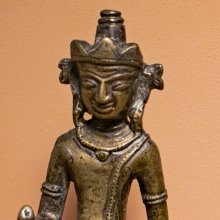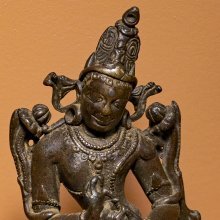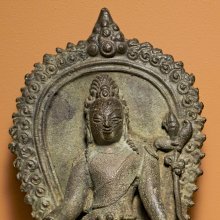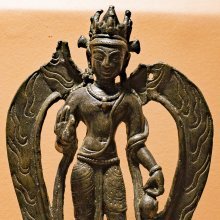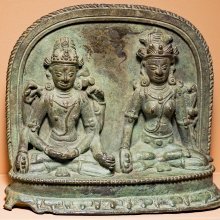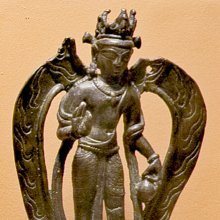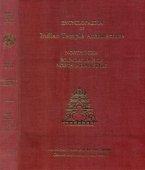Pala, Palā, Pāla: 44 definitions
Introduction:
Pala means something in Buddhism, Pali, Hinduism, Sanskrit, Jainism, Prakrit, the history of ancient India, Marathi, Hindi, biology, Tamil. If you want to know the exact meaning, history, etymology or English translation of this term then check out the descriptions on this page. Add your comment or reference to a book if you want to contribute to this summary article.
Alternative spellings of this word include Paal.
Images (photo gallery)
(+16 more images available)
In Hinduism
Ayurveda (science of life)
Rasashastra (Alchemy and Herbo-Mineral preparations)
Source: Wisdom Library: Rasa-śāstraPala (पल) is a Sanskrit unit of weight corresponding to “50 grams”. It is commonly used in Rasaśāstra literature (Medicinal Alchemy) such as the Rasaprakāśasudhākara or the Rasaratna-samuccaya. Pala is a weight unit often used in various Ayurvedic recipes and Alchemical preparations.
Source: History of Science in South Asia: Making Gems in Indian Alchemical LiteraturePala (पल) refers to unit of measurement approximately translating to “48g or ml”.—Srinivasan (1979: 94) equates one pala with between 46–51 grams.
Kalpa (Formulas, Drug prescriptions and other Medicinal preparations)
Source: Shodhganga: Edition translation and critical study of yogasarasamgrahaPala (पल) refers to a unit of measurement of weight (1 pala equals 48mg; 2 palas = 1 prasṛti = 96g), as defined in the 15th-century Yogasārasaṅgraha (Yogasara-saṅgraha) by Vāsudeva: an unpublished Keralite work representing an Ayurvedic compendium of medicinal recipes. The Yogasārasaṃgraha [mentioning pala] deals with entire recipes in the route of administration, and thus deals with the knowledge of pharmacy (bhaiṣajya-kalpanā) which is a branch of pharmacology (dravyaguṇa).
A relative overview of weight-units is found below, pala indicated in bold. In case of liquids, the metric equivalents would be the corresponding litre and milliliters.
1 Ratti or Guñjā = 125mg,
8 Rattis - 1 Māṣa = 1g,
4 Māṣa - 1 Kaḻañc = 4g,
12 Māṣas - 1 Karṣa = 12g,
1 Karṣa /Akṣa - 1 Niṣka = 12g,
2 Karṣas - 1 Śukti = 24g,
2 Śukti - 1 Pala = 48g,
2 Palas - 1 Prasṛti = 96g,
2 Prasṛtis - 1 Kuḍava = 192g,
2 Kuḍava - 1 Mānikā = 384g,
2 Mānikās - 1 Prastha (Seru) = 768g,
4 Prasthas - 1 Āḍhaka (Kaṃsa) = 3.072kg,
4 Āḍhakas or Kalaśas - 1 Droṇa = 12.288kg,
2 Droṇas - 1 Surpa = 24.576kg,
2 Surpas - 1 Droṇī (Vahi) = 49.152kg,
4 Droṇīs - 1 Khari = 196.608kg,
1 Pala = 48g,
100 Palas - 1 Tulā = 4.8kg,
20 Tulās - 1 Bhāra = 96kg.
Unclassified Ayurveda definitions
Source: Wisdom Library: Āyurveda and botanyPala (पल) is the Sanskrit name for a weight unit corresponding to ‘40 grams’ used in Ayurvedic literature, according to the Ṣoḍaśāṅgahṛdayam. A single Pala unit corresponds to 2 Śukti units (a single Śukti unit equals 20 grams). You need 2 Pala units to make a single Prasṛta unit (1 Prasṛta equals 80 grams). You need a 100 Pala units to make a single Tulā unit (1 Tulā equals 4 kilograms).
Below follows a table of the different weight units in relation to one another and their corresponding values in brackets:
- Guñjā (Raktikā) = 1 seed of Guñjā
- 8 Raktikā = 1 Māṣa (1 gram)
- 10 Māṣa = 1 Karṣa (10 grams)
- 2 Karṣa = 1 Śukti (20 grams)
- 2 Śukti = 1 Pala (40 grams)
- 2 Pala = 1 Prasṛta (80 grams)
- 2 Prasṛta = 1 Kuḍava (Añjali) (160 grams)
- 2 Kuḍava = 1 Śarāva (320 grams)
- 2 Śarāva = 1 Prastha (640 grams)
- 4 Prastha = 1 Āḍhaka (Pātra) (2.56 kilograms)
- 4 Āḍhaka = 1 Droṇa (10.24 kilograms)
- 4 Droṇa = 1 Droṇī (40.96 kilograms)
- 100 Pala = 1 Tulā (4 kilograms).
Pala (पल):—A unit of Measurement; Four karshas will make one pala i. e 48 g of metric units

Āyurveda (आयुर्वेद, ayurveda) is a branch of Indian science dealing with medicine, herbalism, taxology, anatomy, surgery, alchemy and related topics. Traditional practice of Āyurveda in ancient India dates back to at least the first millenium BC. Literature is commonly written in Sanskrit using various poetic metres.
Purana and Itihasa (epic history)
Source: archive.org: Puranic Encyclopedia1) Pala (पल).—A measure of ancient times. (See under Trasareṇu).
2) Pāla (पाल).—A serpent born of the race of Vāsuki. This serpent committed suicide at the Sarpasatra of Janamejaya. (Śloka 51, Chapter 57, Ādi Parva).
Source: archive.org: Shiva Purana - English Translation1) Pala (पल) refers to a unit of time-measurement, consisting of 6 niśvāsas (respirations), according to the Śivapurāṇa 2.1.10, while explaining the span of life of the deities (Brahmā, Viṣṇu and Hara):—“[...] in the case of all living beings, Brahmā, Viṣṇu, Hara, Gandharvas, serpents, Rākṣasas, etc., twenty one thousand six hundred respirations constitute the period of one day and one night (ahorātra), O foremost among Devas. Six respirations constitute the period of time one Pala. Sixty such Palas constitute one Ghaṭī. Sixty Ghaṭīs constitute one day and one night. (6 x 60 x 60 = 21600). There is no limit to the number of respirations of Sadāśiva. Hence He is undecaying”.
2) Pala (पल) refers to a unit for measurement of weight, corresponding to ten ṭaṅkas, according to the Śivapurāṇa 2.1.14:—“twenty full lotuses (kamalā) constitute one prastha measure. A Thousand Bilva leaves (bilvapatra) constitute half a prastha. Petals of lotuses (śatapatra), a thousand in number constitute half a prastha. Ten ṭaṅka weight constitutes one pala and sixteen palas make one prastha. Flowers for worship shall be weighed in the balance according to this calculation. The worship thus duly performed shall accord all cherished desires. If the devotee worships with no specific desires he will become Śiva himself”.
Source: Cologne Digital Sanskrit Dictionaries: The Purana IndexPala (पल).—A measurement: thirteen palas make one Māgadha measure, (jalaprastha, Vāyu-purāṇa): [n.b. 40 palas make at present one Madras measure.]*
- * Brahmāṇḍa-purāṇa IV. 1. 217; Vāyu-purāṇa 100. 219; Viṣṇu-purāṇa VI. 3. 8.

The Purana (पुराण, purāṇas) refers to Sanskrit literature preserving ancient India’s vast cultural history, including historical legends, religious ceremonies, various arts and sciences. The eighteen mahapuranas total over 400,000 shlokas (metrical couplets) and date to at least several centuries BCE.
Kavya (poetry)
Source: Shodhganga: The Kavyamimamsa of RajasekharaPāla (पाल) is the name a locality mentioned in Rājaśekhara’s 10th-century Kāvyamīmāṃsā.—In the Kāvyamīmāṃsā the words Pāla and Mañjara occur in two places. These both places appear joined together and said to be the Janapadas as well as mountains situated in the Dakṣināpatha. Therefore, these two also be taken as one word and identified with Pāla near Mahad.

Kavya (काव्य, kavya) refers to Sanskrit poetry, a popular ancient Indian tradition of literature. There have been many Sanskrit poets over the ages, hailing from ancient India and beyond. This topic includes mahakavya, or ‘epic poetry’ and natya, or ‘dramatic poetry’.
Jyotisha (astronomy and astrology)
Source: Wikibooks (hi): Sanskrit Technical TermsPala (पल).—1. Latitude. 2. Unit of time equivalent to 24 seconds. Note: Pala is a Sanskrit technical term used in ancient Indian sciences such as Astronomy, Mathematics and Geometry.
Source: academia.edu: Tessitori Collection I (astronomy)Pala (पल) refers to “1/60th part of ghaṭī”, according to the Karaṇakutūhala by Bhāskara (classified as literature dealing with astronomy, astrology, divination, medicine) of which a commentary is included in the collection of manuscripts at the ‘Vincenzo Joppi’ library, collected by Luigi Pio Tessitori during his visit to Rajasthan between 1914 and 1919.—According to prof. S.R. Sarma: “The manuscript of the Karaṇakutūhala starts with the enumeration of the laṅkodayas (right ascensions or the rising times of the zodiac signs at laṅkā, the terrestrial equator) and teaches how to compute from the svodayas (oblique ascensions or rising times at one’s own latitude). A table at the top on 1v displays the two sets of parameters. These parameters are given in palas (= 1/60th part of ghaṭī). The oblique ascensions in the bottom row of the table on 1v are obtained by subtracting or adding the ascensional differences (carakhaṇḍas) in the middle row from/to the right ascensions in the upper row” (S.R. Sarma).

Jyotisha (ज्योतिष, jyotiṣa or jyotish) refers to ‘astronomy’ or “Vedic astrology” and represents the fifth of the six Vedangas (additional sciences to be studied along with the Vedas). Jyotisha concerns itself with the study and prediction of the movements of celestial bodies, in order to calculate the auspicious time for rituals and ceremonies.
Shilpashastra (iconography)
Source: Shodhganga: The significance of the mūla-beras (śilpa)Palā (“jackfruit”) refers to one of the several “attributes” (āyudha) or “accessories” of a detiy commonly seen depicted in Hindu iconography, defined according to texts dealing with śilpa (arts and crafs), known as śilpaśāstras.—The śilpa texts have classified the various accessories under the broad heading of āyudha or karuvi (implement), including even flowers, animals, and musical instruments. The fruits found in connection with the deities or held in the hands of the deities are, for example, Palā.

Shilpashastra (शिल्पशास्त्र, śilpaśāstra) represents the ancient Indian science (shastra) of creative arts (shilpa) such as sculpture, iconography and painting. Closely related to Vastushastra (architecture), they often share the same literature.
Shaktism (Shakta philosophy)
Source: Google Books: ManthanabhairavatantramPala (पल) refers to the “waters of meat”, according to the Manthānabhairavatantra, a vast sprawling work that belongs to a corpus of Tantric texts concerned with the worship of the goddess Kubjikā.—Accordingly, “I will (now) talk about the offering of libation (tarpaṇa) to the deities in the gathering (melaka), sacred seats, primary and secondary, the fields, or in the maṇḍala and in the middle of the wheel. Libation should be offered (in these places) with the waters of meat [i.e., pala], liquor, kuśa grass and sesame seeds. The gods who are fierce, tranquil and valorous are (all) pleased by this”.

Shakta (शाक्त, śākta) or Shaktism (śāktism) represents a tradition of Hinduism where the Goddess (Devi) is revered and worshipped. Shakta literature includes a range of scriptures, including various Agamas and Tantras, although its roots may be traced back to the Vedas.
Yoga (school of philosophy)
Source: ORA: Amanaska (king of all yogas): A Critical Edition and Annotated Translation by Jason BirchPala (पल) refers to Unit of Time (equivalent to 24 seconds) (i.e., 6 Prāṇas x 4 seconds), according to the Amanaska Yoga treatise dealing with meditation, absorption, yogic powers and liberation.—Accordingly, as Īśvara says to Vāmadeva: “[...] [Now], I shall define the nature of that highest, mind-free absorption which arises for those devoted to constant practice. [...] Remaining in absorption for the [following] times; moments, breaths, Palas [i.e., palaka], Nāḍīs, Praharas, days, months and years, [the Yogin] then goes to the highest reality. A breath consists of an inspiration and expiration. A palas is regarded as six breaths. A ghaṭikā corresponds in time to sixty palas. [...]”.

Yoga is originally considered a branch of Hindu philosophy (astika), but both ancient and modern Yoga combine the physical, mental and spiritual. Yoga teaches various physical techniques also known as āsanas (postures), used for various purposes (eg., meditation, contemplation, relaxation).
General definition (in Hinduism)
Source: Wisdom Library: HinduismPāla (पाल) is a Sanskrit word referring to ‘herdsman’. Also see avipāla, ‘shepherd ’.
In Buddhism
Theravada (major branch of Buddhism)
Source: Pali Kanon: Pali Proper NamesSee Cullapala, Mahapala, and Cakkhupala.
Theravāda is a major branch of Buddhism having the the Pali canon (tipitaka) as their canonical literature, which includes the vinaya-pitaka (monastic rules), the sutta-pitaka (Buddhist sermons) and the abhidhamma-pitaka (philosophy and psychology).
Mahayana (major branch of Buddhism)
Source: Wisdom Library: Maha Prajnaparamita SastraPāla (पाल) refers to “guardians”, according to Mahāprajñāpāramitāśāstra (chapter 21).—Accordingly, “If the immoral man takes the monastic robes, these are like burning brass for him, like an iron ring around his body; his alms bowl is like a jar filled with melted copper; when he takes his food, it is as if he were swallowing balls of burning iron or drinking boiling brass; the people paying homage to him with their offerings are like the guardians of hell (naraka-pāla) watching over him; when he enters the monastery, it is as though he were entering the great hell; when he sits on the monastic benches, it is as if he were taking his place on a bed of burning iron”.

Mahayana (महायान, mahāyāna) is a major branch of Buddhism focusing on the path of a Bodhisattva (spiritual aspirants/ enlightened beings). Extant literature is vast and primarely composed in the Sanskrit language. There are many sūtras of which some of the earliest are the various Prajñāpāramitā sūtras.
In Jainism
Jain philosophy
Source: archive.org: Anekanta Jaya Pataka of Haribhadra SuriPala (पल) refers to a “weight equal to 4 karṣas”, as occurring in the Anekāntajayapatākā-prakaraṇa, a Śvetāmbara Jain philosophical work written by Haribhadra Sūri.—[Cf. Vol. II, P. 7, l. 6]—See p. 323.
-
General definition (in Jainism)
Source: archive.org: Personal and geographical names in the Gupta inscriptions (jainism)Pāla (पाल) is a Prakrit ending for deriving proper personal names, mentioned as an example in the Aṅgavijjā chapter 26. This chapter includes general rules to follow when deriving proper names. The Aṅgavijjā (mentioning pāla) is an ancient treatise from the 3rd century CE dealing with physiognomic readings, bodily gestures and predictions and was written by a Jain ascetic in 9000 Prakrit stanzas.

Jainism is an Indian religion of Dharma whose doctrine revolves around harmlessness (ahimsa) towards every living being. The two major branches (Digambara and Svetambara) of Jainism stimulate self-control (or, shramana, ‘self-reliance’) and spiritual development through a path of peace for the soul to progess to the ultimate goal.
India history and geography
Source: archive.org: Ceylon Branch of the Royal Asiatic Society 1963Pala is the name of a tank that was situated in the Upalabijaka district: a locality that existed in the ancient kingdom of Anurādhapura, Ceylon (Sri Lanka).
Source: Project Gutenberg: Castes and Tribes of Southern India, Volume 1Pala (“milk”) is one of the exogamous septs (divisions) among the Malas (considered the Pariahs of the Telugu country) of the Daindla section. The Mala people are almost equally inferior in position to the Madigas and have, in their various sub-divisions, many exogamous septs (e.g., Pala).
Source: Cologne Digital Sanskrit Dictionaries: Indian Epigraphical GlossaryPala.—(EI 9, 21, 30; CII 3), name of a weight. (IA 26), a weight equal to 320 ratīs; sometimes spelt phala in Pāli. (CITD), in Telugu-Kannaḍa records, a weight equal to that of 10 pagodas; four karṣas or (1/100) of a tula; the 8th part of a ser, or 3 tolas or rupees; 4 tolas or 320 guñjās. (CII 3), the sixtieth division of a ghaṭī; equal to twenty- four English seconds. Note: pala is defined in the “Indian epigraphical glossary” as it can be found on ancient inscriptions commonly written in Sanskrit, Prakrit or Dravidian languages.
--- OR ---
Pālā.—(LP), sheds. (LP), a foot-soldier; cf. Gujarātī pāḻo. Note: pālā is defined in the “Indian epigraphical glossary” as it can be found on ancient inscriptions commonly written in Sanskrit, Prakrit or Dravidian languages.
--- OR ---
Pala.—weight of 320 ratis (cf. śatamāna); equal to 4 or 5 suvarṇas according to the Yājñavalkyasmṛti. Note: pala is defined in the “Indian epigraphical glossary” as it can be found on ancient inscriptions commonly written in Sanskrit, Prakrit or Dravidian languages.
Source: Shodhganga: Temple management in the Āgamas (history)Pāla is the name of an ancient dynasty from Bengal where Shaivism thrived between the 10th and 12th centuries, according to Dr. Akhilesh K. Dubey (2005). He notes several grants to temples, Śaiva Brāhmaṇas and ascetics of śaiva mutts. The Cāhamānas (of Śākambharī, Jāvalīpura and Naḍḍūla), the Paramāras of Mālvā, Pālas and Senas of Bengal, the Gāhaḍavālas of Kanauj, the Candellas and the Kalacūrīs of Tripurī were all staunch Śaivites. There is also evidence of Śaiva Brāhmaṇas migrating from various places to propagate their wisdom and teachings.
Source: Shodhganga: Elements of Art and Architecture in the Trtiyakhanda of the Visnudharmottarapurana (history)Pala refers to a certain period in the history of Indian Art.—The chronological order of the development of Indian Art as stated in The Heritage of Indian Art is as follows—[...] 10. Pāla and Śena dynasties of Magadha and Bengal belongs to 700-1200 A.D. These two dynasties give great contribution towards the field of Art and Architecture. Brick temple of Paharpur, stone sculptures and bronzes are famous in that time.

The history of India traces the identification of countries, villages, towns and other regions of India, as well as mythology, zoology, royal dynasties, rulers, tribes, local festivities and traditions and regional languages. Ancient India enjoyed religious freedom and encourages the path of Dharma, a concept common to Buddhism, Hinduism, and Jainism.
Biology (plants and animals)
Source: Wisdom Library: Local Names of Plants and DrugsPala in the Hindi language is the name of a plant identified with Ehretia microphylla Lam. from the Boraginaceae (Forget-me-not) family having the following synonyms: Carmona retusa. For the possible medicinal usage of pala, you can check this page for potential sources and references, although be aware that any some or none of the side-effects may not be mentioned here, wether they be harmful or beneficial to health.
Pala [பலா] in the Tamil language is the name of a plant identified with Artocarpus heterophyllus from the Moraceae (Mulberry) family having the following synonyms: Artocarpus integer, Artocarpus integrifolia, Artocarpus jaca.
Pala in the Malayalam language is the name of a plant identified with Cryptolepis grandiflora Wight from the Apocynaceae (Oleander) family having the following synonyms: Cryptolepis wightiana.
Pala [పాల] in the Telugu language is the name of a plant identified with Oxystelma esculentum from the Apocynaceae (Oleander) family.
Pala in the Malayalam language is the name of a plant identified with Cryptostegia grandiflora Cryptostegia grandiflora (Roxb.) R. Br. from the Apocynaceae (Oleander) family.
Source: Google Books: CRC World Dictionary (Regional names)1) Pala in India is the name of a plant defined with Alstonia scholaris in various botanical sources. This page contains potential references in Ayurveda, modern medicine, and other folk traditions or local practices It has the synonym Beluttakaka malabarica Kuntze (among others).
2) Pala is also identified with Anamirta cocculus It has the synonym Menispermum lacunosum Lam. (etc.).
3) Pala is also identified with Artocarpus heterophyllus It has the synonym Artocarpus integer auct. - sensu mult. (etc.).
4) Pala is also identified with Artocarpus integrifolius It has the synonym Artocarpus integrifolia L.f..
5) Pala is also identified with Carmona microphylla It has the synonym Ehretia buxifolia var. latisepala Gagnepain (etc.).
6) Pala is also identified with Gisekia pharnaceoides It has the synonym Pharnaceum occultum Forsk.) (Latin pharnacion or pharnaceon, ii was applied by Plinius to a plant, a species of panax, so named after Pharnaces, the name of two kings of Pontus (etc.).
7) Pala is also identified with Pavonia odorata It has the synonym Hibiscus oligosandrus Buch-Ham. (etc.).
8) Pala is also identified with Tabernaemontana divaricata It has the synonym Reichardia grandiflora Dennst. (etc.).
9) Pala is also identified with Wrightia arborea It has the synonym Beaumontia wallichii (A. DC.) Walp. (etc.).
10) Pala is also identified with Wrightia tinctoria.
11) Pala in Nigeria is also identified with Pentaclethra macrophylla It has the synonym Harpalyce macrocarpa Britton & P. Wilson.
Example references for further research on medicinal uses or toxicity (see latin names for full list):
· Transactions of the Linnean Society of London (1821)
· Hortus Bengalensis, or ‘a Catalogue of the Plants Growing in the Hounourable East India Company's Botanical Garden at Calcutta’ (1814)
· Journal of Ethnopharmacology (2005)
· Kongel. Danske Vidensk. Selsk. Naturvidensk. Math. Afh. (1828)
· Fitoterapia (1997)
· Systema Vegetabilium (1819)
If you are looking for specific details regarding Pala, for example pregnancy safety, health benefits, side effects, chemical composition, extract dosage, diet and recipes, have a look at these references.

This sections includes definitions from the five kingdoms of living things: Animals, Plants, Fungi, Protists and Monera. It will include both the official binomial nomenclature (scientific names usually in Latin) as well as regional spellings and variants.
Languages of India and abroad
Pali-English dictionary
Source: BuddhaSasana: Concise Pali-English Dictionarypala : (nt.) a certain weight (of about 4 ounces). || pāla (m.) a guard; keeper; protector.
Source: Sutta: The Pali Text Society's Pali-English DictionaryPala, (-°) (classical Sk. pala) a certain weight (or measure), spelt also phala (see phala2), only in cpd. sata° a hundred (carat) in weight Th. 1, 97 (of kaṃsa); J. VI, 510 (sataphala kaṃsa=phalasatena katā kañcana-pātī C.). Also in combination catuppala — tippala — dvipala — ekapala — sāṭikā Vism. 339. (Page 439)
— or —
Pāla, (-°) (fr. pā, see pāleti) a guard, keeper, guardian, protector S. I, 185 (vihāra°); J. V, 222 (dhamma°); VvA. 288 (ārāma°); Sdhp. 285. See also go°, loka°. (Page 455)

Pali is the language of the Tipiṭaka, which is the sacred canon of Theravāda Buddhism and contains much of the Buddha’s speech. Closeley related to Sanskrit, both languages are used interchangeably between religions.
Marathi-English dictionary
Source: DDSA: The Molesworth Marathi and English Dictionarypala (पल).—n (S) The sixtieth part of a ghaṭikā. Two and a half are one minute. 2 m S Terrestrial latitude.
--- OR ---
paḷa (पळ).—n (pala S) The sixtieth part of a ghaṭikā or the 160th part of an hour. 2 A weight of twenty-eight ḍhabū;--used in weighing butter, ghee &c.
--- OR ---
paḷa (पळ).—m (paḷaṇēṃ) A general flight (as of the people of a town, village, or country, of a routed army &c.) v suṭa. Also, by meton., the fleeing people. Ex. āmacyā gāṃvānta paḷa ālā āhē. 2 f A run, a wild running from. v ghē. Also a run or race; a run as struck up. v māra. 3 f C A course or channel to drain fields. paḷa kāḍhaṇēṃ To take to flight; to scamper off. 2 g. of o. To make to run or to flee. paḷa suṭaṇēṃ in. con. To fall a scampering, fleeing, or running.
--- OR ---
paḷā (पळा).—m ( H) A large metal ladle. paḷī f A ladle gen.
--- OR ---
pāla (पाल).—f (palli S) The common house-lizard.
--- OR ---
pāla (पाल).—n A cloth or a large blanket &c. stretched across a pole, forming a sort of tent with two sloping sides and two open ends. 2 A thick sort of cloth used as carpeting. 3 m A large fighting vessel. 4 (pallava) The tender shoots (of grass or trees). v phuṭa, nigha, yē, hō. pāla ghālaṇēṃ or māṇḍaṇēṃ To set up openly the trade of a prostitute.
--- OR ---
pāla (पाल) [or पालक, pālaka].—a (S) That supports, cherishes, protects. In comp. as bhūpāla, mahīpāla.
--- OR ---
pālā (पाला).—m (pallava S) Leaves, blades, tufts of leaves, foliage.
--- OR ---
pāḷa (पाळ).—n pāḷaka n A ramification of the root of a tree. 2 fig. Scattered, diffused, or outspread state (of things gen.) v ghāla, māṇḍa, pasara, paḍa. pāḷēmpāḷēṃ khaṇūna ṭākaṇēṃ g. of o. To hoist out, oust, uproost; to turn out root and branch, neck and crop.
--- OR ---
pāḷa (पाळ).—f (pāli S) A parapet or marginal wall (as built around wells or tanks). 2 The raised edge of the mouth of a handmill. 3 The outer and curving edge of the auricle, the helix: the lower edge of the nose &c. 4 The ring of bundles (of kaḍabā, sarama &c.) which, at thrashing time, is made around the khaḷēṃ or thrashing floor to confine the corn from being scattered: the ring (of earth, lime &c.) around the cavity wherein water is to be poured: the similar ring of the āḷēṃ or cavity around the foot of a tree: the circle of flour around a mill: the ring or crown of the glacis around a fort: an encircling line of trees, stakes, men &c.: a ring in many similar applications. 5 A furrow (as made by a rush of water).
--- OR ---
pāḷa (पाळ).—a Free from taxation, exempt--a beast &c.; as cāra mhaśī pāḷa āhēta. Also remitted or waved--a tax; as gharadēṇēṃ pāḷa āhē. Also released from the payment of a tax--a person or family.
--- OR ---
pāḷa (पाळ) [or पाळक, pāḷaka].—a (Properly pāla & pālaka) That supports, cherishes, protects, defends. Esp. in comp. as bhūpāḷa, lōkapāḷa.
--- OR ---
pāḷā (पाळा).—m A small wood-bill. 2 W (pāḷaṇēṃ) Obedience, keeping of commands. 3 (Poetry. pāli S) An encircling body or line. Ex. hātīṃ ghēūnī ghana- sāṃvaḷā || vrajāṅganā dharitī pāḷā. 4 An encircling body; a band, troop, party, company gen. Ex. bhūtāñcē pāḷē apāra || mandarācaḷīṃ miḷālē ||. Also a flock or herd or any assemblage or multitude. Ex. jaisē gurāñcē pāḷē bahuta || ēka gurākhī rākhīta ||. 5 Scattered or outspread state (of things in general). v ghāla, māṇḍa, pasara, pāḍa & paḍa. 6 The name of a small white-reddish sea-fish.
Source: DDSA: The Aryabhusan school dictionary, Marathi-Englishpala (पल).—n The sixtieth part of a ghaṭikā. Two and a half are one minute. m Terres- trial latitude.
--- OR ---
paḷa (पळ).—n The sixtieth part of a ghaṭikā. m A general flight, The feeling people paḷa kāḍhaṇēṃ To take to flight; to scamper off. To make to run or to flee. paḷa suṭaṇēṃ in con. To fall a feeling.
--- OR ---
paḷā (पळा).—m A large metal ladle.
--- OR ---
pāla (पाल).—f The common house-lizard.
--- OR ---
pāla (पाल).—n A piece of cloth stretched across a pole, forming a sort of tent with two sloping sides and two open ends. A thick cloth used as carpeting.
--- OR ---
pāla (पाल) [or pālaka, or पालक].—a That supports, protects.
--- OR ---
pālā (पाला).—m Leaves, foliage.
--- OR ---
pāḷa (पाळ).—n pāḷaka n A root of a tree. pāḷēṃ muḷēṃ khaṇūna kāḍhaṇēṃ To uproot; to turn out root and branch.
--- OR ---
pāḷa (पाळ).—f A parapet or marginal wall (as built around wells or tanks).
--- OR ---
pāḷa (पाळ).—a Free from taxation, exempt-a beast &c., as cāra mhaśī pāḷa āhēta. Remit- ted-a tax; as ghara dēṇēṃ pāḷa āhē.
--- OR ---
pāḷa (पाळ) [or pāḷaka, or पाळक].—a That supports, protects.
--- OR ---
pāḷā (पाळा).—m A small wood-bill. Obedience. An encircling body or line. A flock or herd.
Marathi is an Indo-European language having over 70 million native speakers people in (predominantly) Maharashtra India. Marathi, like many other Indo-Aryan languages, evolved from early forms of Prakrit, which itself is a subset of Sanskrit, one of the most ancient languages of the world.
Sanskrit dictionary
Source: DDSA: The practical Sanskrit-English dictionaryPala (पल).—[pal-ac] Straw, husk.
-lam 1 Flesh, meat.
2) A particular weight equal to four karṣas.
3) A particular measure of fluids.
4) A particular measure of time.
5) A small measure; लवणपलमिव क्षिप्तमन्तर्ह्रदस्य (lavaṇapalamiva kṣiptamantarhradasya) Nāg.5.24.
Derivable forms: palaḥ (पलः).
--- OR ---
Palā (पला).—The plant जटामांसी (jaṭāmāṃsī), Indian spikenard; ग्रन्थिकं च पलां चव्यं (granthikaṃ ca palāṃ cavyaṃ)...... Śiva B.3.16.
--- OR ---
Pāla (पाल).—1 [पाल्-अच् (pāl-ac)] A protector, guardian, keeper; as in गोपालः, वृष्णिपालः (gopālaḥ, vṛṣṇipālaḥ), &c.
2) A herdsman; विवादः स्वामि- पालयोः (vivādaḥ svāmi- pālayoḥ) Manusmṛti 8.5,229,24.
3) A kind; अहो अधर्मः पालानाम् (aho adharmaḥ pālānām) Bhāgavata 1.18.33.
4) A spitting-pot.
-lī 1 A herdsman's wife; Mahābhārata (Bombay) 5.
2) An oblong pond.
Derivable forms: pālaḥ (पालः).
Source: Cologne Digital Sanskrit Dictionaries: Shabda-Sagara Sanskrit-English DictionaryPala (पल).—n.
(-laṃ) 1. A weight of gold or silver equal to four Karshas or Suvarnas; also of four or of eight Tolas, or in common use, of three Tolas, two Mashas, and eight Rattis. 2. A moment, the sixtieth part of an Indian hour. 3. Flesh. m.
(-laḥ) Straw after threshing, &c. E. pal to go, to move, aff. ac .
--- OR ---
Pāla (पाल).—mfn.
(-laḥ-lī-laṃ) Who or what guards or preserves. m.
(-laḥ) 1. A nourisher, a protector. 2. A spitting-pot. 3. A herdsman. 4. A king. f. (-lī) 1. The sharp edge of a sword. 2. A woman with a beard. 3. A louse. 4. A line, a row or range. 5. A pot, a boiler. E. pāl to nourish, aff. ac; ṅīṣ added; also with i aff. pāli.
Source: Cologne Digital Sanskrit Dictionaries: Benfey Sanskrit-English DictionaryPala (पल).—n. 1. A weight = 4 kar- ṣas, [Mānavadharmaśāstra] 8, 135. 2. Flesh, [Yājñavalkya, (ed. Stenzler.)] 3, 215.
--- OR ---
Pāla (पाल).—[pā + la] 2., m. One who guards or protects, [Rāmāyaṇa] 1, 42, 15 Gorr.
Source: Cologne Digital Sanskrit Dictionaries: Cappeller Sanskrit-English DictionaryPala (पल).—[neuter] a cert. weight (also [masculine]) or measure; flesh, meat.
--- OR ---
Pāla (पाल).—1. [masculine] guard, protector, herdsman ([feminine] ī), king; a man’s name.
--- OR ---
Pāla (पाल).—2. [masculine] [neuter] alms-pot.
Source: Cologne Digital Sanskrit Dictionaries: Monier-Williams Sanskrit-English Dictionary1) Pala (पल):—m. (scarcely to be connected with [preceding]) straw, [cf. Lexicographers, esp. such as amarasiṃha, halāyudha, hemacandra, etc.]
2) = pāla [gana] jvalādi
3) n. a [particular] weight = 4 Karṣas = 1/100 Tulā (rarely m.; ifc. f(ā). ), [Manu-smṛti; Yājñavalkya; Suśruta] etc.
4) n. a [particular] fluid measure, [Nirukta, by Yāska xiv, 7; Kātyāyana-śrauta-sūtra [Scholiast or Commentator]]
5) a [particular] measure of time (= 1/60 Ghaṭī), [Gaṇitādhyāya]; flesh, meat, [Yājñavalkya; Suśruta]
6) cf. [Latin] palea; Fr. paille, [Lithuanian] pelai.
7) Pāla (पाल):—[from pāl] m. (ifc. f(ā). ) a guard, protector, keeper, [Rāmāyaṇa; Harivaṃśa]
8) [v.s. ...] a herdsman, [Manu-smṛti; Gautama-dharma-śāstra; Yājñavalkya; Mahābhārata]
9) [v.s. ...] protector of the earth, king. prince, [Bhāgavata-purāṇa]
10) [v.s. ...] (also n.) a spitting spittoon (as ‘recipient’ ?), [cf. Lexicographers, esp. such as amarasiṃha, halāyudha, hemacandra, etc.]
11) [v.s. ...] Name of a serpent-demon of the race of Vāsuki, [Mahābhārata]
12) [v.s. ...] of a prince, [Catalogue(s)]
13) [v.s. ...] (with bhaṭṭa) Name of an author, [ib.]
14) [v.s. ...] Name of a dynasty (that reigned over Gauḍa and the adjacent countries from about 800-1050 [Apte’s The Practical Sanskrit-English Dictionary]D.).
Source: Cologne Digital Sanskrit Dictionaries: Yates Sanskrit-English Dictionary1) Pala (पल):—(laṃ) 1. n. A weight of gold or silver; a minute; flesh. m. Straw.
2) Pāla (पाल):—[(laḥ-lā-laṃ) a.] Protecting. m. A protector; a spitting pot. f. Edge of a sword; bearded woman; louse; row; pot; a flock.
Source: DDSA: Paia-sadda-mahannavo; a comprehensive Prakrit Hindi dictionary (S)Pala (पल) in the Sanskrit language is related to the Prakrit words: Pala, Palia, Pāla.
[Sanskrit to German]
Sanskrit, also spelled संस्कृतम् (saṃskṛtam), is an ancient language of India commonly seen as the grandmother of the Indo-European language family (even English!). Closely allied with Prakrit and Pali, Sanskrit is more exhaustive in both grammar and terms and has the most extensive collection of literature in the world, greatly surpassing its sister-languages Greek and Latin.
Hindi dictionary
Source: DDSA: A practical Hindi-English dictionary1) Pala (पल) [Also spelled pal]:—(nm) a measure of time equivalent to twenty-four seconds; —[bhara] ([ko]) for a while, for a moment; •[meṃ] in a moment, instantaneously; —[meṃ tolā pala meṃ māśā] to chop and change, to play fast and loose.
2) Pāla (पाल) [Also spelled paal]:—(nf) a sail; the layers of straw, leaves, etc, between which unripe mangoes (and some other fruits) are ripened within doors; a suffix denoting a protector, maintainer, manager administrator, etc. (as [rājyapāla, lekhapāla] etc.); —[kā pakā] ripened in [pāla; ~ghara] sail-loft; —[meṃ ḍālanā] to keep fruits under layers of straw etc. to ripen.
3) Pālā (पाला):—(nm) frost; side; concern; (a) reared, nurtured, brought up, fostered, tended; cherished; —[paḍanā] to be frost-hit; to be devastated, to suffer destruction; —[paḍanā, kisī se] to have to contend with; to be confronted with (a difficult person etc.); to face a difficult person in hostility and defiance; —[māranā] to be frost-hit, to be frost-bitten.
...
Prakrit-English dictionary
Source: DDSA: Paia-sadda-mahannavo; a comprehensive Prakrit Hindi dictionary1) Pala (पल) in the Prakrit language is related to the Sanskrit word: Pal.
2) Pala (पल) also relates to the Sanskrit word: Parā.
3) Pala (पल) also relates to the Sanskrit word: Pala.
4) Pāla (पाल) also relates to the Sanskrit word: Pāla.
5) Pāla (पाल) also relates to the Sanskrit word: Pāla.
Prakrit is an ancient language closely associated with both Pali and Sanskrit. Jain literature is often composed in this language or sub-dialects, such as the Agamas and their commentaries which are written in Ardhamagadhi and Maharashtri Prakrit. The earliest extant texts can be dated to as early as the 4th century BCE although core portions might be older.
Kannada-English dictionary
Source: Alar: Kannada-English corpusPala (ಪಲ):—
1) [adjective] consisting of some large, indefinite number (of persons or things); numerous ; many.
2) [adjective] relatively numerous; too many.
--- OR ---
Pala (ಪಲ):—
1) [noun] a fruit of any plant, whether edible or not.
2) [noun] a long,hand-held, sharp-edged, pointed weapon, used for cutting, thrusting, etc. by soldiers; a sword.
3) [noun] the sharp blade of a sword.
4) [noun] greediness; covetousness; avariciousness.
--- OR ---
Pala (ಪಲ):—
1) [noun] (hist.) a unit of weight (equal to three tolas).
2) [noun] a unit of time, equal to twenty four seconds.
3) [noun] (hist.) a unit of capacity.
4) [noun] the flesh of animals used as food; meat.
5) [noun] any of several grasses.
6) [noun] the creeper Trichosanthes cucumerina of Cucurbitaceae family and its gourd.
--- OR ---
Paḷa (ಪಳ):—[adjective] (only as the first word in a compound) old.
--- OR ---
Paḷa (ಪಳ):—
1) [noun] a fruit of any plant, whether edible or not.
2) [noun] a long, hand-held, sharp-edged, pointed weapon, used for cutting, thrusting, etc. by soldiers; a sword.
3) [noun] the sharp blade of a sword.
4) [noun] greediness; covetousness; avariciousness.
--- OR ---
Paḷa (ಪಳ):—
1) [noun] (hist.) a unit of weight (equal to three tolas).
2) [noun] a unit of time, equal to twenty four seconds.
3) [noun] (hist.) a unit of capacity.
4) [noun] the flesh of animals used as food; meant.
5) [noun] any of several grasses.
6) [noun] the creeper Trichosanthes cucumerina of Cucurbitaceae family.
7) [noun] its gourd.
--- OR ---
Paḻa (ಪೞ):—[adjective] (only as the first word in a compound) old.
--- OR ---
Pāla (ಪಾಲ):—[noun] a species of small owl, that is supposed to give indication of what will happen in future.
--- OR ---
Pāla (ಪಾಲ):—
1) [noun] the part of the face between the eyebrows and the line where the hair normally begins; the forehead.
2) [noun] the share of a plough; a ploughshare.
--- OR ---
Pāla (ಪಾಲ):—
1) [noun] a man who takes care of or protects.
2) [noun] a jarlike container to spit into; a spittoon; cuspidor.
3) [noun] a protecting; an instance of this; protection.
--- OR ---
Pāla (ಪಾಲ):—
1) [noun] the plant Zingiber officinale of Zingiberaceae family; common ginger plant.
2) [noun] its rhizome used as a spice.
--- OR ---
Pālā (ಪಾಲಾ):—[noun] association; friendship; companionship; ಪಾಲಾ ಫೂ ಬಿಡು [pala phu bidu] pālāphū biḍu = ಪಾಲಾ ಬಿಡು [pala bidu]; ಪಾಲಾ ಬಿಡು [pala bidu] pālābiḍu (children’s term) to sever one’s friendship; ಪಾಲಾ ಹಿಡಿ [pala hidi] pālāhiḍi (children’s term) to reunite friendship.
--- OR ---
Pāḷa (ಪಾಳ):—[noun] a solemn declaration, made in the name of a god, that one would do or refrain from doing something or pledge oneself to something; a vow.
--- OR ---
Pāḷa (ಪಾಳ):—
1) [noun] the part of the face between the eyebrows and the line where the hair normally begins; the forehead.
2) [noun] the share of a plough; a ploughshare.
Kannada is a Dravidian language (as opposed to the Indo-European language family) mainly spoken in the southwestern region of India.
Tamil dictionary
Source: DDSA: University of Madras: Tamil LexiconPala (பல) pronominal cf. bahula. [K. hala, M. pala.] Many, several, diverse; ஒன்றுக்கு மேற் பட்டவை. பலவற் றிறுதி யுருபிய னிலையும் [onrukku mer pattavai. palavar riruthi yurupiya nilaiyum] (தொல். எழுத். [thol. ezhuth.] 220).
--- OR ---
Pala (பல) [palattal] 11 intransitive verb < பலம்³. [palam³.]
1. To be or become strong; வலிமையாதல். [valimaiyathal.]
2. To become heavy, severe, as rain, wind, disease, etc.; கடுமையாதல். [kadumaiyathal.]
3. To become prosperous or luxuriant; செழித்தல். [sezhithal.] (W.)
--- OR ---
Palā (பலா) noun < phala. Jack-tree, large tree, Artocarpus integrifolia; மரவகை. பலாப்பழத் தீயி னொப்பாய் [maravagai. palappazhath thiyi noppay] (திருவாசகம் [thiruvasagam] 6, 46).
--- OR ---
Palā (பலா) noun < balā. Rose-coloured sticky mallow. See சிற்றாமுட்டி. [sirramutti.] (தைலவருக்கச்சுருக்கம் தைல. [thailavarukkachurukkam thaila.] 25.)
--- OR ---
Paḷā (பளா) interjection See பளாபளா. [palapala.]
--- OR ---
Pālā (பாலா) noun probably from bhalla. Spear; கை யீட்டி. [kai yitti.] Local usage
Tamil is an ancient language of India from the Dravidian family spoken by roughly 250 million people mainly in southern India and Sri Lanka.
See also (Relevant definitions)
Starts with (+838): Paala, Pal-arukukuttutal, Pala bariki, Pala benda, Pala bhatta, Pala chettu, Pala dantam, Pala kettu, Pala kodesa, Pala kodisha, Pala lelaki, Pala malle, Pala sugandhi, Pala teega, Pala-aricol, Pala-benda, Pala-corrutannir, Pala-cosharokam, Pala-garuda, Pala-gurji.
Ends with (+1026): Aaduthoda pala, Aalapala, Aattukottappala, Abalagopala, Abhayapala, Abhipala, Abhumipala, Acapala, Achapala, Acyutaraghunatha bhupala, Adhipala, Adipala, Aduthinnappala, Agnipala, Agnishomiyaikadashakapala, Agopala, Agrimonia gryposepala, Aiyapala, Ajapala, Ajayapala.
Full-text (+1518): Vipala, Karapala, Kanakapala, Dashapala, Bhogapala, Apala, Bhupala, Kshitipala, Pashupala, Palagni, Kalyapala, Palika, Palamkara, Pancapala, Palanga, Kudava, Pal, Khandapala, Kuruvista, Prastha.
Relevant text
Search found 117 books and stories containing Pala, Paḷa, Paḷā, Pālā, Palā, Pāla, Pāḷa, Pāḷā, Paḻa, Palaa, Paalaa; (plurals include: Palas, Paḷas, Paḷās, Pālās, Palās, Pālas, Pāḷas, Pāḷās, Paḻas, Palaas, Paalaas). You can also click to the full overview containing English textual excerpts. Below are direct links for the most relevant articles:
Manusmriti with the Commentary of Medhatithi (by Ganganatha Jha)
Verse 8.135 < [Section XXIII - Measures]
Verse 8.397 < [Section XLVIII - Laws relating to Civic Misdemeanours]
Verse 11.214 < [Section XXIX - Description of the Expiatory Penances]
Amarakoshodghatana of Kshirasvamin (study) (by A. Yamuna Devi)
Economics (4): Measures, Weights and Coinage < [Chapter 3 - Social Aspects]
Flora (12): Mushrooms < [Chapter 5 - Aspects of Nature]
Daily Life (1): Food and Drinks < [Chapter 3 - Social Aspects]
Garga Samhita (English) (by Danavir Goswami)
Verse 8.13.4b < [Chapter 13 - A Thousand Names of Lord Balarāma]
Verse 1.2.21 < [Chapter 2 - Description of the Abode of Śrī Goloka]
Verse 2.8.12 < [Chapter 8 - Description of Seeing Lord Kṛṣṇa]
Chaitanya Bhagavata (by Bhumipati Dāsa)
Verse 2.17.94 < [Chapter 17 - The Lord’s Wandering Throughout Navadvīpa and Descriptions of the Devotees’ Glories]
Verse 1.9.84 < [Chapter 9 - Nityānanda’s Childhood Pastimes and Travels to Holy Places]
Verse 3.10.110 < [Chapter 10 - The Glories of Śrī Puṇḍarīka Vidyānidhi]
Brihad Bhagavatamrita (commentary) (by Śrī Śrīmad Bhaktivedānta Nārāyana Gosvāmī Mahārāja)
Verse 1.5.9 < [Chapter 5 - Priya (the beloved devotees)]
Verse 1.2.93-94 < [Chapter 2 - Divya (the celestial plane)]
Verse 1.3.65 < [Chapter 3 - Prapañcātīta (beyond the Material Plane)]
Kautilya Arthashastra (by R. Shamasastry)
Chapter 19 - The Superintendent of Weights and Measures < [Book 2 - The duties of Government Superintendents]
Chapter 1 - Protection against Artisans < [Book 4 - Removal of Thorns]
Chapter 15 - The Superintendent of Store-house < [Book 2 - The duties of Government Superintendents]
Related products
